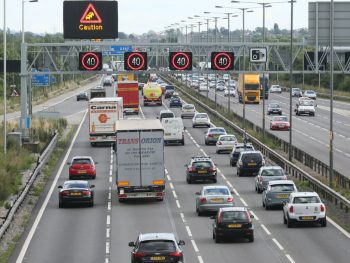Further action needed on smart motorways, says RAC
The RAC has called for further action on smart motorways, following an inquest into the deaths of two people on a smart motorway section of the M1 motorway.

In its review of smart motorways, the Government committed to an 18-point package of measures
The inquest concerned the deaths of Jason Mercer and Alexandru Murgeanu, who died when Prezemyslaw Szuba crashed his lorry into their vehicles near Sheffield on 7 June 2019.
Held at Sheffield Town Hall, the inquest yesterday (18 January) saw coroner David Urpeth record a verdict of unlawful killing and call for a smart motorway review.
As reported by the BBC, Mr Urpeth said smart motorways without a hard shoulder carry “an ongoing risk of future deaths”. It was also suggested at the inquest that the deaths of the two men may have been avoided if there had been a hard shoulder on the motorway.
In its statement, Highways England extended its deepest sympathies to the families of Alexandru Murgeanu and Jason Mercer.
It also said that it will carefully consider any further comments raised by the coroner once the report is out – but added that it’s already addressing many of the points raised by the coroner, as published in the Government’s Smart Motorway Evidence Stocktake and Action Plan of March 2020.
The result of a review announced by the Department for Transport into smart motorways, the 18-point package of measures includes abolishing “confusing” dynamic hard shoulder motorways and substantially speeding up the deployment of radar-based Stopped Vehicle Detection (SVD) tech so that it is installed across the entire smart motorway network within 36 months. Without such systems it takes Highways England more than 17 minutes to spot a broken-down vehicle in a live lane. Yet in March 2020 they were only used on 25 miles of smart motorway on the M25.
The changes under the plans will also ensure that the distance between SOS areas is reduced to 3/4 of a mile where feasible and a maximum of one mile by installing additional emergency areas.
The plans also committed to putting more Highways England patrol officers on certain stretches of smart motorway, and pledged an additional £5m for national, targeted communication campaigns to further increase drivers’ knowledge and understanding of smart motorways and how to use them confidently.
However, 10 months on from the publication of the plans and the RAC has said that that while “some good progress has been made by adding more SOS areas to the M25 and developing a new standard for future schemes”, more work needs to be done.
Head of roads policy Nicholas Lyes commented: “The introduction of SVD technology is a vital element of this and is due to be retrofitted to existing smart motorways as well as schemes currently under construction. Sadly, there appears to have been precious little progress with retrofitting to date considering this was announced last March. While Highways England is considering a national programme to install more SOS areas on the existing network, we’d prefer them to commit to this fully so all refuge areas are consistent distances apart.”
The RAC has also called for more details of whether the promise of additional traffic officer patrols has been fulfilled, saying this “will be a crucial ingredient in providing extra protection for drivers that are unfortunate enough to be stranded in a dangerous live-lane scenario”.
Lyes continued: “While we’re very supportive of stopped vehicle detection technology, the success of it still depends on other drivers seeing and obeying red ‘X’ closed-lane signs. If drivers don’t see these because gantries or verge-mounted signs are too far apart, then there’s still a risk of collision with a stationary vehicle.”
Since the RAC’s comments, Highways England has published some updates on its work to enhance the safety of smart motorways. This includes installing SVD technology on the M3, which it says will typically detect a stopped vehicle in a live lane within 20 seconds. Work has begun to install the technology on the M20. Work is due to start on the M1 in February. All motorways where the hard shoulder has been converted to a permanent lane will have stopped vehicle detection by March 2023.
It’s also made more than 300 emergency areas on smart motorways more visible for drivers and installed 10 new emergency areas on the M25 .
Other work includes updating the requirements for the design of future motorway upgrades so that when they enter their design stage there will be a maximum distance of one mile between places to stop in an emergency and updating the design requirements for converting dynamic hard shoulder motorways.













Gary Hewitt20. Jan, 2021
I was so pleased to hear the coroner at Monday’s inquest state what the vast majority of British motorists have known for years – Smart Motorways, in their current form, are not safe. No amount of tinkering, such as the minor detail changes and “considered” alterations included in Grant Shapps whitewash of a review, will rectify that fact. There really is no substitute for a continuous, dedicated and permanent hard shoulder, our lifeline, allowing drivers to get out of the path on motorway-speed traffic following behind. Sure, there are plenty of other innovations within the wider Smart Motorway project which could and should be retained, such as managed traffic flow, variable and appropriate speed limits and advance warnings of road conditions up ahead. These features alone would help to smooth traffic flow within the existing 3 lanes, easing congestion and making our motorways safer. However, a hard shoulder is an essential safety feature of every motorway, and our lifeline MUST be restored where it has been stolen from us. The British motoring public deserve nothing less.